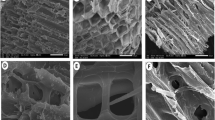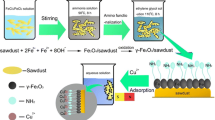Abstract
In this work, phosphorus oxychloride was grafted onto the surface of raw sawdust (RSD) particles to get effective adsorbent for capturing Cd(II), Cr(III), and Pb(II) metal ions from aqueous medium. Phosphorylated raw sawdust (RSD@P) was characterized by FTIR, TGA, SEM-EDX, TEM, BET, and XPS analyses. Various experimental conditions of adsorption viz. pH, contact time, temperature, and initial concentration were optimized. The adsorption behavior of RSD@P concerning adsorption kinetics, isotherms and thermodynamics was also studied. The values of qe for Cd(II), Cr(III), and Pb(II) metal ions onto RSD@P was found to be 244.3, 325, and 217 mg/g, respectively at 298 K according to monolayer Langmuir adsorption. The adsorption kinetics data revealed that Cd(II), Cr(III), and Pb(II) metal ions were well fitted to pseudo-second-order kinetic model. The thermodynamic results demonstrated that adsorption was spontaneous and exothermic. The mechanisms of interactions was also discussed for the adsorption of Cd(II), Cr(III), and Pb(II) metal ions over RSD@P. The obtained results showed that RSD@P was an auspicious adsorbent which showed outstanding reusability for the removal of metal ions from aqueous medium.

Highlights
-
Crosslinked phosphorylated raw sawdust (RSD@P) was prepared.
-
The material (RSD@P) was used for the removal of Cd(II), Cr(III), and Pb(II) from aqueous medium.
-
Adsorption of all metal ions onto RSD@P was rapid, spontaneous, and exothermic.
-
The values of qe for Cd(II), Cr(III), and Pb(II) was 244.3, 325, and 217 mg/g, respectively.
-
The RSD@P was regenerated by simply washing with 0.1 M HCl solution.










Similar content being viewed by others
References
Saad M, Saeed A, Hotan I (2017) Preconcentration of heavy metals on multiwalled carbon nanotubes in water samples prior to analysis using FAAS. 69:5004. https://doi.org/10.5004/dwt.2017.0426
Alsohaimi IH, Wabaidur SM, Kumar M et al. (2015) Synthesis, characterization of PMDA/TMSPEDA hybrid nano-composite and its applications as an adsorbent for the removal of bivalent heavy metals ions. Chem Eng J 270:9–21. https://doi.org/10.1016/j.cej.2015.02.008
Alqadami A, Naushad M, Abdalla MA et al. (2016) Synthesis and characterization of Fe3O4@TSC nanocomposite: Highly efficient removal of toxic metal ions from aqueous medium. RSC Adv 6:22679–22689. https://doi.org/10.1039/C5RA27525C
Kamel MM, El-mgeed AMA, El-hewaihy MAI (2013) Synthesis of a novel tannin–formaldehyde resin from Acacia nilotica fruit extract and its viability for adsorption of manganese from ground water. 1236–1248. https://doi.org/10.2166/ws.2013.133
Rafatullah M, Sulaiman O, Hashim R, Ahmad A (2009) Adsorption of copper (II), chromium (III), nickel (II) and lead (II) ions from aqueous solutions by meranti sawdust. J Hazard Mater 170:969–977. https://doi.org/10.1016/j.jhazmat.2009.05.066
Halttunen T, Salminen S, Tahvonen R (2007) Rapid removal of lead and cadmium from water by specific lactic acid bacteria. 114:30–35. https://doi.org/10.1016/j.ijfoodmicro.2006.10.040
Venditti F, Ceglie A, Palazzo G et al. (2007) Removal of chromate from water by a new CTAB–silica gelatin composite. J Colloid Interface Sci 310:353–361. https://doi.org/10.1016/j.jcis.2007.02.019
Mendoza-Castillo DI, Rojas-Mayorga CK, García-Martínez IP et al. (2015) Removal of heavy metals and arsenic from aqueous solution using textile wastes from denim industry. Int J Environ Sci Technol 12:1657–1668. https://doi.org/10.1007/s13762-014-0553-8
Awual MR, Hasan MM, Naushad M et al. (2015) Preparation of new class composite adsorbent for enhanced palladium(II) detection and recovery. Sens Actuators, B Chem 209:790–797. https://doi.org/10.1016/j.snb.2014.12.053
AlOthman ZA, Alam MM, Naushad M (2013) Heavy toxic metal ion exchange kinetics: Validation of ion exchange process on composite cation exchanger nylon 6,6 Zr(IV) phosphate. J Ind Eng Chem 19:956–960. https://doi.org/10.1016/j.jiec.2012.11.016
Naushad M, ALOthman ZA, Awual MR et al. (2015) Adsorption kinetics, isotherms, and thermodynamic studies for the adsorption of Pb2+ and Hg2+ metal ions from aqueous medium using Ti(IV) iodovanadate cation exchanger. Ion 21:2237–2245. https://doi.org/10.1007/s11581-015-1401-7
Naushad M, Mittal A, Rathore M, Gupta V (2015) Ion-exchange kinetic studies for Cd(II), Co(II), Cu(II), and Pb(II) metal ions over a composite cation exchanger. Desalin Water Treat 54:2883–2890. https://doi.org/10.1080/19443994.2014.904823
Naushad M, Ahamad T, Al-Maswari BM et al. (2017) Nickel ferrite bearing nitrogen-doped mesoporous carbon as efficient adsorbent for the removal of highly toxic metal ion from aqueous medium. Chem Eng J 330:1351–1360. https://doi.org/10.1016/j.cej.2017.08.079
Naushad M, Khan MR, ALOthman ZA et al. (2016) Water Purification Using Cost Effective Material Prepared from Agricultural Waste: Kinetics, Isotherms, and Thermodynamic Studies. Clean Soil, Air, Water 44:1036–1045. https://doi.org/10.1002/clen.201600027
Yavuz Ö, Guzel R, Aydin F, et al. (2007) Removal of cadmium and lead from aqueous solution by calcite. 16:467–471.
Alqadami AA, Khan MA, Otero M et al. (2018) A magnetic nanocomposite produced from camel bones for an efficient adsorption of toxic metals from water. J Clean Prod 178:293–304. https://doi.org/10.1016/j.jclepro.2018.01.023
Siddiqui MR, Wabaidur SM, Khan MA, et al. (2017) A rapid and sensitive evaluation of nitrite content in Saudi Arabian processed meat and poultry using a novel ultra performance liquid chromatography–mass spectrometry method. J Food Sci Technol https://doi.org/10.1007/s13197-017-2908-x
Bryant PS, Petersen JN, Lee JM, Brouns TM (1992) Sorption of heavy metals by untreated red fir sawdust. Appl Biochem Biotechnol 34:777–788. https://doi.org/10.1007/BF02920596
Yu B, Zhang Y, Shukla A et al. (2000) The removal of heavy metal from aqueous solutions by sawdust adsorption—removal of copper. J Hazard Mater 80:33–42. https://doi.org/10.1016/S0304-3894(00)00278-8
Jeon C, Kim JH (2009) Removal of lead ions using phosphorylated sawdust. J Ind Eng Chem 15:910–913. https://doi.org/10.1016/j.jiec.2009.09.023
Zhu G, Deng X, Hou M et al. (2016) Comparative study on characterization and adsorption properties of activated carbons by phosphoric acid activation from corncob and its acid and alkaline hydrolysis residues. Fuel Process Technol 144:255–261. https://doi.org/10.1016/j.fuproc.2016.01.007
Matos J, Nahas C, Rojas L, Rosales M (2011) Synthesis and characterization of activated carbon from sawdust of Algarroba wood. 1. Physical activation and pyrolysis. J Hazard Mater 196:360–369. https://doi.org/10.1016/j.jhazmat.2011.09.046
Fuente E, Menéndez JA, Díez MA et al. (2003) Infrared spectroscopy of carbon materials: a quantum chemical study of model compounds. J Phys Chem B 107:6350–6359. https://doi.org/10.1021/jp027482g
Karaosmanoǧlu F, Işıḡıgür-Ergüdenler A, Sever A (2000) Biochar from the Straw-Stalk of Rapeseed Plant. Energy & Fuels 14:336–339. https://doi.org/10.1021/ef9901138
Bose S, Das C (2015) Sawdust: From wood waste to pore-former in the fabrication of ceramic membrane. Ceram Int 41:4070–4079. https://doi.org/10.1016/j.ceramint.2014.11.101
Guo Y, Rockstraw DA (2007) Physicochemical properties of carbons prepared from pecan shell by phosphoric acid activation. Bioresour Technol 98:1513–1521. https://doi.org/10.1016/j.biortech.2006.06.027
Puziy AM, Poddubnaya OI, Martı́nez-Alonso A et al. (2002) Synthetic carbons activated with phosphoric acid: I. Surface chemistry and ion binding properties. Carbon N Y 40:1493–1505. https://doi.org/10.1016/S0008-6223(01)00317-7
Ahamad T, Naushad M, Al-Maswari BM, et al. (2017) Synthesis of a recyclable mesoporous nanocomposite for efficient removal of toxic Hg2+ from aqueous medium. J Ind Eng Chem https://doi.org/10.1016/j.jiec.2017.04.035
Naushad M, AL-Othman ZA, Islam M (2013) Adsorption of cadmium ion using a new composite cation-exchanger polyaniline Sn(IV) silicate: Kinetics, thermodynamic and isotherm studies. Int J Environ Sci Technol 10:567–578. https://doi.org/10.1007/s13762-013-0189-0
Awual MR, Hasan MM, Eldesoky GE et al. (2016) Facile mercury detection and removal from aqueous media involving ligand impregnated conjugate nanomaterials. Chem Eng J 290:243–251. https://doi.org/10.1016/j.cej.2016.01.038
Gan W, Gao L, Zhan X, Li J (2016) Preparation of thiol-functionalized magnetic sawdust composites as an adsorbent to remove heavy metal ions. RSC Adv 6:37600–37609. https://doi.org/10.1039/C6RA02285E
Qi W, Zhao H, Wu Y, et al. (2017) Facile Synthesis of Layer Structured GeP 3/C with Stable Chemical Bonding for Enhanced Lithium-Ion Storage. 1–7. https://doi.org/10.1038/srep43582
Al-Enizi AM, Naushad M, Al-Muhtaseb AH et al. (2018) Synthesis and characterization of highly selective and sensitive Sn/SnO2/N-doped carbon nanocomposite (Sn/SnO2@NGC) for sensing toxic NH3 gas. Chem Eng J 345:58–66. https://doi.org/10.1016/j.cej.2018.03.138
Wang W, Kan Y, Pan H et al. (2017) Phosphorylated cellulose applied for the exfoliation of LDH: An advanced reinforcement for polyvinyl alcohol. Compos Part A Appl Sci Manuf 94:170–177. https://doi.org/10.1016/j.compositesa.2016.11.031
Ibrahim MNM, Ngah WSW, Norliyana MS et al. (2010) A novel agricultural waste adsorbent for the removal of lead (II) ions from aqueous solutions. J Hazard Mater 182:377–385. https://doi.org/10.1016/j.jhazmat.2010.06.044
Alqadami AA, Khan MA, Siddiqui MR, Alothman ZA (2018) Development of citric anhydride anchored mesoporous MOF through post synthesis modification to sequester potentially toxic lead (II) from water. Microporous Mesoporous Mater. https://doi.org/10.1016/j.micromeso.2017.11.016
Alqadami AA, Naushad M, Abdalla MA et al. (2016) Adsorptive Removal of Toxic Dye Using Fe3O4–TSC Nanocomposite: Equilibrium, Kinetic, and Thermodynamic Studies. J Chem Eng Data 61:3806–3813. https://doi.org/10.1021/acs.jced.6b00446
Alqadami AA, Naushad M, Abdalla MA, et al. (2017) Efficient removal of toxic metal ions from wastewater using a recyclable nanocomposite: A study of adsorption parameters and interaction mechanism. J Clean Prod https://doi.org/10.1016/j.jclepro.2017.04.085
Etim UJ, Umoren SA, Eduok UM (2016) Coconut coir dust as a low cost adsorbent for the removal of cationic dye from aqueous solution. J Saudi Chem Soc 20:S67–S76. https://doi.org/10.1016/j.jscs.2012.09.014
Heidari A, Younesi H, Mehraban Z, Heikkinen H (2013) Selective adsorption of Pb(II), Cd(II), and Ni(II) ions from aqueous solution using chitosan–MAA nanoparticles. Int J Biol Macromol 61:251–263. https://doi.org/10.1016/j.ijbiomac.2013.06.032
Reddy DHK, Seshaiah K, Reddy AVR et al. (2010) Biosorption of Pb2 + from aqueous solutions by Moringa oleifera bark: Equilibrium and kinetic studies. J Hazard Mater 174:831–838. https://doi.org/10.1016/j.jhazmat.2009.09.128
Freundlich HMF (1906) No title over the adsorption in solution. J Phys Chem 57:385–471
Langmuir I (1918) The adsorption of gases on plane surfaces of glass, mica and platinum. J Am Chem Soc 40:1361–1403. https://doi.org/10.1021/ja02242a004
Khan MA, Wallace WT, Islam SZ et al. (2017) Adsorption and recovery of polyphenolic flavonoids using TiO2-functionalized mesoporous silica nanoparticles. ACS Appl Mater Interfaces 9:32114–32125. https://doi.org/10.1021/acsami.7b09510
Memon SQ, Memon N, Shah SW, et al. (2007) Sawdust— green and economical sorbent for the removal of cadmium (II) ions. 139:116–121. https://doi.org/10.1016/j.jhazmat.2006.06.013
Albadarin AB, Mangwandi C, Walker GM et al (2009) Biosorption characteristics of sawdust for the removal of Cd (II) ions: mechanism and thermodynamic studies. Chem Eng Trans 24:1297–1302
Lim J, Kang H, Kim L, Ko S (2008) Removal of heavy metals by sawdust adsorption: Equilibrium and kinetic studies. Environ Eng Res 13:79–84
Lanka S (2017) Removal of Cr (III) Ions from wastewater using sawdust and rice husk biochar pyrolyzed at low temperature removal of Cr (III) ions from wastewater using sawdust and rice husk biochar pyrolyzed at low temperature. Int J Innovation Educ Res 4:44–54
Bulut Y, Tez Z (2007) Removal of heavy metals from aqueous solution by sawdust adsorption. J Environ Sci 19:160–166. https://doi.org/10.1016/S1001-0742(07)60026-6
Lagergren S (1898) About the theory of so-called adsorption of soluble substances. Zur theorie der sogenannten adsorption gel?ster stoffe. 24:1–39
Ho YS, McKay G (1998) Sorption of dye from aqueous solution by peat. Chem Eng J 70:115–124. https://doi.org/10.1016/S0923-0467(98)00076-1
Alqadami AA, Naushad M, Alothman ZA, Ghfar AA (2017) Novel Metal–Organic Framework (MOF) Based Composite Material for the Sequestration of U(VI) and Th(IV) Metal Ions from Aqueous Environment. ACS Appl Mater Interfaces 9:36026–36037. https://doi.org/10.1021/acsami.7b10768
Acknowledgements
The authors extend their appreciation to the Deanship of Scientific Research at King Saud University for funding this work through Research Group No. (RG-1436-034).
Author information
Authors and Affiliations
Corresponding author
Ethics declarations
Conflict of interest
The authors declare that they have no conflict of interest.
Electronic supplementary material
Rights and permissions
About this article
Cite this article
Alhumaimess, M.S., Alsohaimi, I.H., Alqadami, A.A. et al. Synthesis of phosphorylated raw sawdust for the removal of toxic metal ions from aqueous medium: Adsorption mechanism for clean approach. J Sol-Gel Sci Technol 89, 602–615 (2019). https://doi.org/10.1007/s10971-018-4870-0
Received:
Accepted:
Published:
Issue Date:
DOI: https://doi.org/10.1007/s10971-018-4870-0




